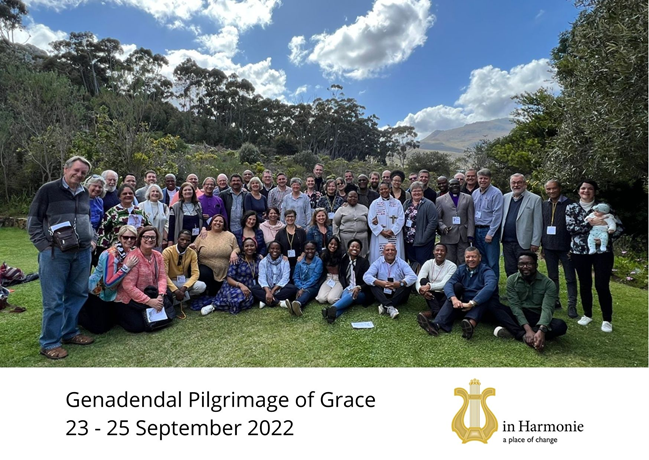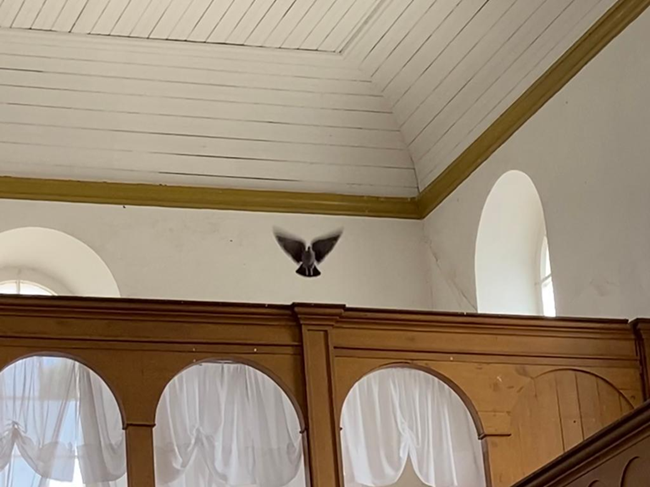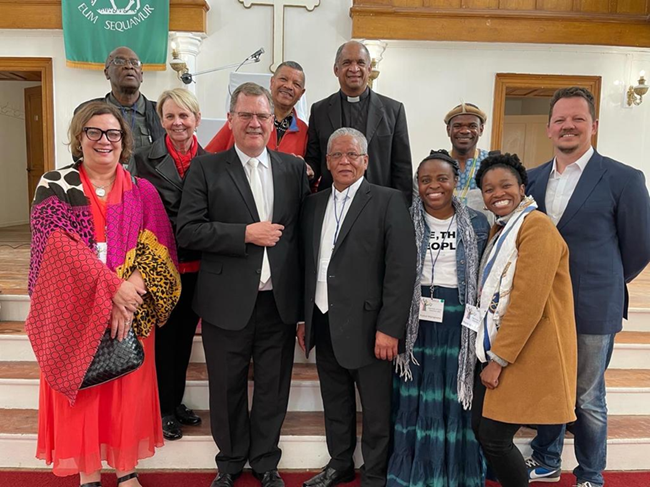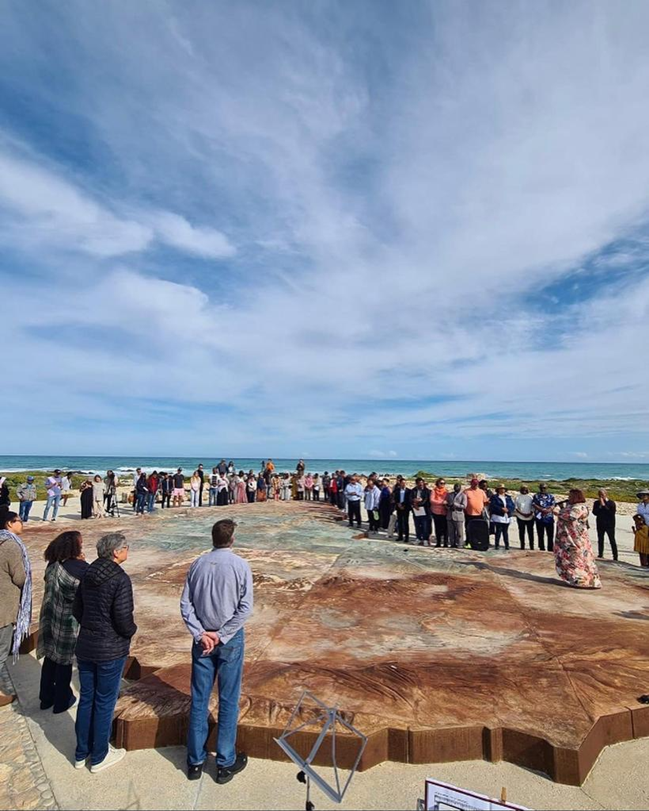Johannes Reimer of the World Evangelical Alliance recounts a series of reconciliation events that occurred in South Africa a few weeks ago.
The Pilgrimage of Grace, held Sept. 23-25, 2022, was an unforgettable and amazing series of reconciliation events, mainly between Dutch Reformed Afrikaaners and Moravian Indigenous South Africans.
Of course reconciliation in post-apartheid South Africa has many other faces, but let me tell you about this series of meetings and travels organized by the South African Christian Leadership Initiative, which works alongside the Evangelical Alliance of South Africa.
 Behind these organizations are prayerful local believers such as Anneke Rabe and Hanneli Rupert-Koechelenberg, who with her family has created in Harmonie, a beautiful place of peace and healing on their vinery estate in Franschhoek.
Behind these organizations are prayerful local believers such as Anneke Rabe and Hanneli Rupert-Koechelenberg, who with her family has created in Harmonie, a beautiful place of peace and healing on their vinery estate in Franschhoek.
Cape Town Indigenous church
Those participating in this pilgrimage, sixty people from different South African denominations and organizations along with a few foreign guests such as myself, started at the Moravian Hill Church in District Six of Cape Town.
Once inhabited by the native Khoi people, this inner-city area was infamous for the inhumane uprooting of the Khoi by the apartheid regime and the taking down their houses and businesses and closing their church. Over 60,000 Khoi were forcibly removed during the 1970s and only after the end of apartheid was the historic church building, dating back to 1886, returned to the Moravians.
This first non-white church in the Cape stands today as a powerful witness of the struggle of the Khoi and other South African tribes for freedom and dignity. A worship service in this church launched our reconciliation pilgrimage, a symbol of reconciliation between the two oldest churches in the country: the white Dutch Reformed Church (DRC) and the indigenous Moravian Church.
For 300 years these two churches had lived in constant tension as the Moravians were dehumanized and mistreated while the DRC stood with the oppressors, even delivering dubious theological justifications for the system of injustice.
But this day demonstrated how they have chosen to close the past, heal their memories and begin a peaceful, meaningful cooperation.
Cape Town Afrikaaner church
After the moving service in the Moravian Hill Church we walked the city, praying for the diverse population and confessing the sins of European invaders at the Castle of Good Hope, now a centre for restoration. Then we approached the Groote Kerk in the centre of Cape Town, built in 1678 and the oldest Christian church in South Africa, the proud spiritual centre of the (white) Afrikaaner church.
The pilgrimage group, now joined by other Capetonians, gathered for worship.
Moos Nthla, the general secretary of the South African Evangelical Alliance, reminded the pilgrims of both the great blessing which grew out of the European Christian presence among the Indigenous African tribes and the unfortunate development of racially segregated Christianity in South Africa. He urgently appealed to his fellow South Africans to overcome that painful history, heal their memories and join hands in building up the kingdom of God among the nations of South Africa.
Stories of personal reconciliation between white and Black brothers and sisters followed the sermon. Praying and singing together, we the pilgrims were ready to move on to Genadendal, where the mission among the Indigenous tribes in South Africa began.
Reformed-Moravian reconciliation
Genadendal (“Valley of Grace”) is a small town in Eastern Cape where the German missionary Georg Schmidt (1709-1785) started his mission among the Khoi people in 1737. In the historic church of Genadendal, established as the first church among the Khoi and San tribes in 1738, the two oldest churches of South Africa stepped forward to reconcile with one another after 300 unreconciled years. For many of those years the DRC persecuted the Moravians.
This milestone event started with an introduction to the history of the tense relationship of the two churches. While this historic problem was being described, a dove flew into the church building and sat down on the gallery above the pulpit.
Then, stunningly, as the gathered people participated in prayers for the reconciliatory act, the dove flew over the sanctuary. We sang together before the moderator of the DRC, pastor N. Janse van Rensburg, read from Scripture and confessed the sins of the DRC to the Moravians and God.
Van Rensburg specifically confessed, “My church stood in the way of God’s mission to African native tribes. We have sinned against God and people – please forgive us.”
While he made his confession, moving us to tears, the dove returned to the front of the church and posted itself again above the pulpit, as if the Holy Spirit was hovering in witness to this historic confession.
His confession was followed by a response by the Moravian leadership. Not only did they forgive the DRC, but also pointed to their own sin, especially towards the neglected acknowledgment of the women in their church.
One reconciliation leads to another
This plea for forgiveness reached the women, and so yet another form of reconciliation, between men and women in the leadership of the Moravian Church, took shape. The names of some of the most extraordinary female leaders among the Moravians were spoken of, along with their contribution to both the mission among the Khoi in the early days and the struggle against the apartheid system in South Africa in the 20th century.
In the end both churches committed to work together to build up God´s kingdom in South Africa beyond racial, ethnic or cultural divides. “We will work together for a nation in which God’s mission embraces all people,” declared the DRC bishop.
I have seldom participated in such a spiritually loaded Christian gathering. God was present in every word, in every piece of music, and in every prayer. Our pilgrimage took us to a place of God’s divine presence. We, the pilgrims, were witnessing God in action.
“Reconciliation is truly the place where our Lord is at home,” a brother from South Africa said after we left the church. He expressed my own feelings and thoughts precisely.
With the end of the service the celebration continued. Young people were involved and the historic bell rang again inviting the faithful to be thankful for what God did in 300 years of history and the for the beginning of new healing of memories of both the Christians from the DRC and the Moravian Church.
Reconciliation centre for young adults
We left Genadendal with hope in our hearts and moved on to another exciting place of peace and reconciliation – Volmoed. Located in a beautiful valley in the Western Cape, this ecumenical centre for peace and reconciliation was established by a small group of dedicated Christians from different denominations around the famous theology professor John W. de Gruchy, author of the influential book, Reconciliation: Restoring Justice.
“All we are concerned about,” de Gruchy said in his welcoming address to our pilgrimage group, “is reconciliation, or the restoration of humanity and nature into God’s original image. Here in Volmoed you find Christians reconciled with one another and with others, working together for peace across all denominational lines. You are welcome to join us in our efforts, and we will obviously be with you on your journey of reconciliation.”
Yes, we felt welcome. “We come here often with our YWAM discipleship school,” explained the leader of YWAM South Africa, M. Filies. “It is exciting to see how our young people from around the world get transformed in Volmoed. Nothing is as true as the fact that God is present here and His Spirit transforms lives to be agents of peace. For many of them their personal pilgrimage of reconciliation starts exactly here. Like Taizé in Europe, Volmoed serves people of interest to make them ambassadors of peace.”
Salt for the continent
The last station on our pilgrimage was Cape Agulhas, the southernmost point of the African continent. Here at the shore where the Indian and Atlantic Oceans meet we circled a huge relief map of the continent.
Here again we confessed the sins of the European nations against African tribes. Great Britain, the Netherlands, France, Germany, Portugal, Spain and in recent years the U.S. and Russia – have all added to the agony of most African nations. Representatives from Europe and the Americas asked the Africans and God for forgiveness and pleaded with the Lord to reconcile us with one another to fulfil our God-given mission.
This was expressed in extensive confessions and lament. And representatives from African nations forgave us and asked God to transform our churches into a united force to be God’s true agents of transformation and peace.
It was thrilling to see reconciled churches cast a joint vision for Africa and the world. In prayer, worship and testimonial stories they encouraged our group to stay active in the mission of reconciliation. They reminded us to be salt of the earth and light of the world.
To illustrate this, pastor Janse van Rensburg gave every participant some salt, and together we covered the map of Africa with salt, promising to be salt – a preservative and nourishing mineral – for the African soil. What a symbol this was!
Our pilgrimage of grace ended at Cape Agulhas, but the mission has not stopped. I suppose many pilgrimages of grace will be needed to reconcile our broken world. We can all actively pray and participate, fellow Christians.
 Dr. Johannes Reimer is director of the department of public engagement of the World Evangelical Alliance. He also teaches at universities in Germany and South Africa. This blog series and related podcasts are produced in collaboration with the Peace & Reconciliation Network. Read all the blog posts at FaithToday.ca/AllThingsReconciled.
Dr. Johannes Reimer is director of the department of public engagement of the World Evangelical Alliance. He also teaches at universities in Germany and South Africa. This blog series and related podcasts are produced in collaboration with the Peace & Reconciliation Network. Read all the blog posts at FaithToday.ca/AllThingsReconciled.